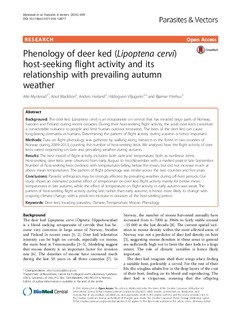| dc.description.abstract | Background: The deer ked (Lipoptena cervi) is an ectoparasite on cervids that has invaded large parts of Norway,
Sweden and Finland during recent decades. During their host-seeking flight activity, the adult deer keds constitute
a considerable nuisance to people and limit human outdoor recreation. The bites of the deer ked can cause
long-lasting dermatitis in humans. Determining the pattern of flight activity during autumn is hence important.
Methods: Data on flight phenology was gathered by walking along transects in the forest in two counties of
Norway during 2009–2013, counting the number of host-seeking keds. We analysed how the flight activity of deer
keds varied depending on date and prevailing weather during autumn.
Results: The best model of flight activity included both date and temperature, both as nonlinear terms.
Host-seeking deer keds were observed from early August to mid-November with a marked peak in late September.
Number of host-seeking keds declined with temperatures falling below the mean, but did not increase much at
above mean temperatures. The pattern of flight phenology was similar across the two counties and five years.
Conclusions: Parasitic arthropods may be strongly affected by prevailing weather during off-host periods. Our
study shows an estimated positive effect of temperature on deer ked flight activity mainly for below mean
temperatures in late autumn, while the effect of temperature on flight activity in early autumn was weak. The
pattern of host-seeking flight activity during late, rather than early autumn, is hence more likely to change with
ongoing climate change, with a predicted increase in duration of the host-seeking period.
Keywords: Deer ked, Invading parasites, Climate, Temperature, Moose, Phenology | nb_NO |

